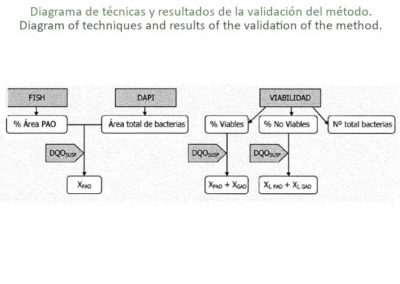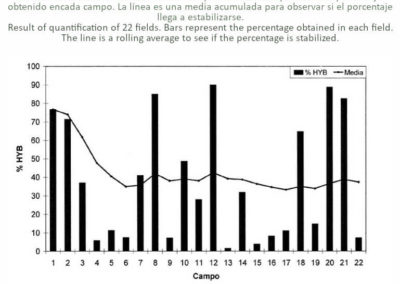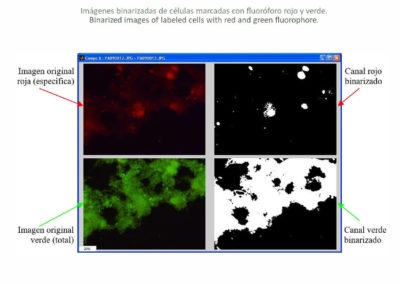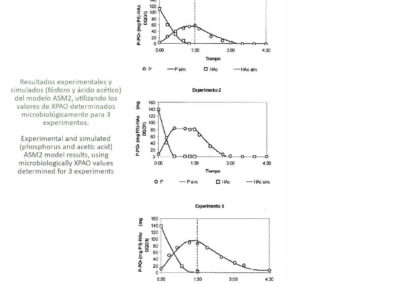Method for determining the contribution of biomass to cod

Description
Characteristics
Images
Description
The method comprises the application of molecular microbiological techniques of in situ hybridation (FISH), staining with DAPI and cell viability to determine the contribution to the chemical oxygen demand of the specific groups of bacteria present in biological waste-water purification processes (heterotrophic bacteria, autotrophic bacteria and polyphosphate-accumulating bacteria, PAO). This method permits the calibration of the mathematical methods of activated sludges in a direct manner without needing to have recourse to optimisation of the results, thereby reducing the uncertainty when determining the calibration parameters for a specific system of waste water treatment.
The present invention has a clear objective with great interest implementation: development of a method for estimation of bacterial populations with an interest in the processes of biological wastewater treatment, and its parameters so that it can be used in models mathematicians are typically employed to design these processes and to analyze its operation. This type of biological processes are the most widely implemented in the treatment of urban waste water (Stations sewage treatment plants, sewage treatment plant), even though the knowledge about the operation of these still significant gaps, in particular as regards the dynamics of microbial populations, of vital importance when justifying the operating results of the WWTP.
The proposed method is a significant improvement in the certainty of the calibration of the mathematical model, as the number of unknown variables to the extent that an optimization of errors mathematical solutions is not necessary is reduced, but can be performed a direct calculation of the model parameters. This prevents obtaining results that can be mathematical but no biological sense.
The combination of molecular microbiological techniques, chemical analysis of water samples and equations that incorporate existing mathematical models, represents a breakthrough in terms of how to use these resources. Incorporating microbiological data obtained directly measures the balance equation COD, is a significant reduction in the number of parameters to determine the mathematical model ASM2. Otherwise, these parameters (XH, XA, XPAO and XI) would be estimated by mathematical optimization methods, greatly reducing the uncertainty of the calibration process model. The XH parameter refers to the percentage of heterotrophic bacteria, XA refers to the percentage of autotrophic bacteria, XPAO refers to the percentage of bacteria accumulating poly-phosphates and XI refers to the percentage of viable bacteria in the sample.
Determining the percentages of bacterial groups and inert matter of the water sample is carried out by molecular microbiological techniques. Molecular microbiological techniques of the present invention are based on identification of bacterial groups by using molecular biology techniques. The molecular biology techniques that can be carried out should allow obtaining data and / or images by which to estimate the representation of different bacterial groups. So, for it can be used traditional breeding techniques and / or molecular biology techniques, labeling with specific probes coupled to fluorophores (technical FISH, fluorescence in situ hybridization), labeling with 4,6-diamidino-2-fenlindol ( DAPI), detection by antibodies, PCR, DNA sequencing, optical microscopy, epifluorescence or confocal without excluding other molecular biology techniques to identify and determine the percentage of bacterial groups in a water sample. If we proceed to obtain images, the analysis can be performed by any manual or computerized procedure for calculating the areas occupied by each of the bacterial groups determine desired.
Acquiring images of the fluorescence emitted by the labeled bacteria techniques described above it is performed by a system capable of engaging the photographed fluorescence microscope. Fluorescence microscopy or laser confocal microscope, with appropriate according to the fluorochromes used filters, to visualize the labeled cells that are excited with the suitable wavelength, so that it can use all the probes in a single sample and select the emission wavelengths of the respective fluorophores that mark the bacterial groups thus obtained images with overlapping marking in the same sample for determining the percentages of each group of bacteria.
Characteristics
Applicants: UNIV VALENCIA POLITECNICA [ES]; UNIV VALENCIA
Inventors: ALONSO MOLINA JOSE LUIS [ES]; BORRAS FALOMIR LUIS [ES]; FERRER POLO JOSE [ES]
Priorities: ES200802851A·2008-10-08
Application: ES200802851A·2008-10-08
Publication: ES2344393A1·2010-08-25
Published as: ES2344393A1; WO2010040872A1





